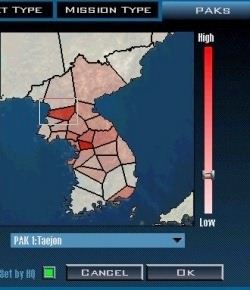| Daring Thrust
by by David "Hunter" Proeber |
||||
|
Tactical Concept Daring Thrust is a 17-hour 15 mission mini-campaign for patch 1.07 that is based on North Korea's attempt to take advantage of a war between Taiwan and China. U.S. F-15s have been withdrawn to aid Taiwan. Three F-16 squadrons remain in South Korea to maintain air superiority. That's your job. You will fly Defensive Counter Air, Combat Air Patrols and Escort missions as air assets from the north attempt to eliminate U.S. armor units blocking a DPRK lightning-like drive to take Seoul. If you fail to intercept DPRK Mi-24s and Su-25s providing air cover, you can loose the entire campaign in three hours. Keep DPRK air forces off U.S. armor battalions and they will destroy the north's field command and control within four hours. Varied levels of success could result in a stalemate and leave the result of this conflict in the hands of the politicians. Political Background Operation Daring Thrust was born out of political opportunism. As tensions between North and South Korea had lessened in recent months, few expected the remote possibility of an invasion by the north. After all, thousands of North Korean peasants continued to live on the verge of starvation. The military itself was close to mutiny as local commanders were no longer capable of paying their troops' wages. As the threat from Korea appeared to lessen, Taiwan's continued march to independence gave rise for great fears across the Pacific. President Clinton attempted to find appeasement with the Chinese following a Republican led Congressional treaty that vowed support to Taiwan should the Chinese launch military action against the Taiwanese independence movement. The worst came to pass after Taiwan business giants and bankers sought to undermine several Asian banks doing business with the mainland. Taiwanese banking officials were well aware that China was ill equipped to deal with the Y2K problem. A plot was hatched that would devalue Chinese currency after January 2nd. |
 Between January 2 and 6, China's financial markets collapsed. Billions disappeared over night as the Y2K bug, coupled with Taiwan's control of several Asian markets, left China almost penniless. With their success, China fell into a recession and worldwide humiliation as its lack of expertise in capitalist business dealings became apparent. In retaliation, China's military was ordered to launch an all out effort to take the island. While it couldn't mount a cross channel invasion, it could level Taiwan's business infrastructure with rocket and air attacks from the mainland. After all, China had no shortage of aging MiG-23 and Chinese made MiG-21 fighters. If the Americans could defeat Serbia with an air campaign, why couldn't China force Taiwan into submission with an air campaign, too? For the first time in history, Chinese air force analysts borrowed several pages from U.S. defense planners' historical archives. Desert Storm and actions over Bosnia and Serbia were copied. Even sophisticated CAPs were scheduled with the best Chinese air assets, MiG-29 and Su-27 fighters. In a little over a day, Taiwan's air force, comprised of dozens of import F-16s, was smashed. Congress and the Clinton administration were in turmoil. The media asked, "What are you going to do?" Go to Part II: the Response
|
|||
|
Copyright © 1997 - 2000 COMBATSIM.COM, INC. All Rights Reserved. Last Updated August 23rd, 1999 |
||||
